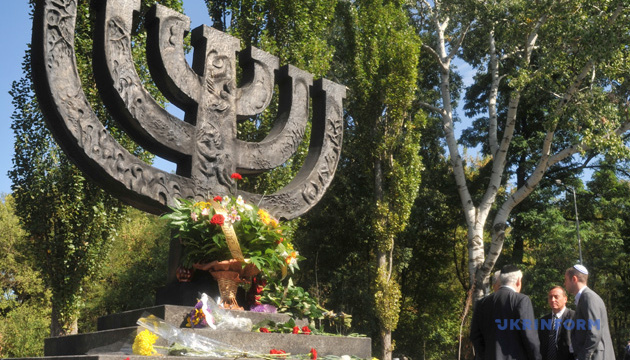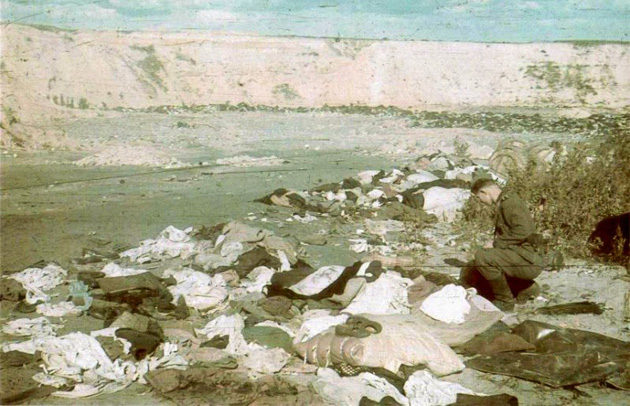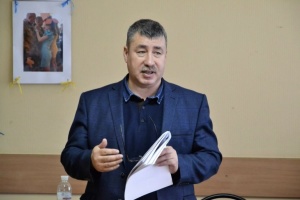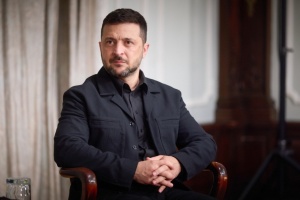
The memory of June 22, 1941: was it possible to avoid many victims among the Jewish population?
June 22 is a tragic anniversary of the invasion by Hitler's troops of the territory of the Soviet Union. At the very beginning of the German Blitzkrieg-1941, the Soviet army showed its incapacity. Retreating, the military left tens of thousands of square kilometers of territory and human lives. Many victims, in particular among the Jewish population, which a priori became a target for the Nazis, could have been avoided, but... The co-president of the “Vaad” of Ukraine, Andrey Adamovskiy, explains how they preserve a special memory of those distant times.
Today the Jewish community has the opportunity to restore the events that preceded the Second World War and the Holocaust on the territory of Ukraine. These events are an integral part of a coherent historical period with its specific (often ugly) features. The Association of Jewish Communities and Organizations of Ukraine (“Vaad”) understands that without knowing the context, it is difficult to explain to contemporaries the tragedy of Babi Yar, as well as the whole fate of the Jewish people in the Ukrainian territories of the first half of the XX century.
“We are implementing two large projects – memorial centers and museums of Babi Yar, as well as “Beit Kadishin” in Chernivtsi. They are completely different, but both will have similar properties in the logic of creating exposures. In both cases attention will be paid to events preceding the Holocaust. A separate block in the museum of Babi Yar will be provided to the interwar period (1939 – 1941). We are talking about the attitude of the Soviet authorities to the fate of the population in the war zone. In Chernivtsi, the pre-war period with its different (primarily political) aspects will also be restored”, says the co-president of the “Vaad” Andrey Adamovskiy.
In 1918-1939 Ukraine did not have statehood. The Jewish, as well as other ethnic communities in the modern territories of the country, were divided between several states. The Polish-Lithuanian Commonwealth included Volyn, Rivne, Lviv, Ivano-Frankivsk, Ternopil regions. Northern Bukovina belonged to Romania with the center in Chernivtsi. Transcarpathia was a part of Czechoslovakia. And the central, southern and eastern parts of Ukraine were part of the USSR. The cultural, economic and social life of the Jewish community in the country of the Soviets was completely different from all the others...

October 1941. Jews have already been massively exterminated at Babi Yar. In the photo - a German soldier near the things of the dead.
Paradoxes of the era
A professional historian – the head of the Ukrainian Center for the Study of the History of the Holocaust, Vice-President of the “Vaad” of Ukraine, candidate of Historical Sciences Anatoliy Podolskiy will help us deal with this ambiguous historical time. He notes the main difference between the life of Jews in the Western territories and under Soviet rule: in Lviv, Uzhgorod, Chernivtsi, Lutsk and other western centers, communities functioned. Whereas in Kharkov, Cherkassy, Zhytomyr and Kyiv there were no communities any more – the Jewish population of Soviet Ukraine remained there.
Hebrew was banned in the mid-1920’s. Yiddish functioned, but the texts were supposed to be exclusively ideologically Soviet. However, as well as with Ukrainian, Polish or other languages. Synagogues, and churches, were closed from 1927 to 1932. They were used as warehouses, factories, clubs. According to the documents, in 1926 the authorities in Kyiv began to persecute and shoot Jews, who remained Zionists and studied Hebrew.
“Soviet authorities erased national identity. At this point, the problems of the Jews are similar to the problems of the Ukrainians. Lenin began the process of so-called indigenization, and Stalin continued. As Lenin said: “Culture must be national in form, socialist in content”. And so it was”, says Anatoliy Podolskiy, vice president of the “Vaad” of Ukraine.
Something similar could not be imagined in modern Western Ukraine. Even despite the fact that anti-Semitism in the Polish-Lithuanian Commonwealth, Romania and Czechoslovakia (to a lesser extent) was open. Because along with anti-Semitism, synagogues functioned there, Jews could receive social assistance in their communities, and also teach children according to religious tradition.
“In Western Ukraine, anti-Semitism was everywhere. But Jewish national, cultural, religious life was not prohibited. Jews had an opportunity to respond to this anti-Semitism. In addition to many newspapers in Polish with anti-Semitic articles, many newspapers were also printed in Polish and Yiddish with philosemitic articles. In the Polish Sejm there were Jewish deputies defending the interests of their people. That is, anti-Semitism in the Ukrainian lands of the Second Polish Republic was open. And anti-Semitism in Soviet Ukraine was latent, hidden. If on the streets of Kyiv in the 1930’s, a Jew was called a “zhyd”, you could get punishment for it. The official position was that in the Soviet Union – “the great homeland of all nations” – there are no phobias. But at the same time, the synagogues are closed, the Hebrew is forbidden, and the Jews of Kyiv are offered to become Soviet people. The propaganda claimed: “Yes, you can not forget that you are a Jew or a Ukrainian, but above all you are Soviet people”, explains Anatoliy Podolskiy.
Trap of ignorance
Despite all the prohibitions on the cultural life of Jewish communities, in the 1920s many Jewish writers returned to the USSR from emigration. David Hofstein, Peretz Markish, David Bergelson – representatives of Jewish literature on the territory of Ukraine in Yiddish. Some literary critics call this trio the actual heirs of Sholem Aleichem. They, like many others, believed Stalin... For example, one of those who returned was the great Ukrainian Mykhailo Hrushevsky, who was actually driven to the ground in several years due to political persecution. “Gofshtein, Markish, Bergelson returned to be shot on August 12, 1952 in the case of the Jewish Anti-Fascist Committee. However, before that, in the 1930s, they became the voice of the Soviet authorities. As the researchers noted, Lenin’s slogan has finally worked: culture is national in form, socialist in content”, says Anatoliy Podolskiy.
“Bergelson and Hofstein, like Tychyna, Rylsky and Bazhan, glorified the Soviet authorities. People made fun of such creative works. Their works were published in Yiddish, Ukrainian, Polish and other languages. It was a tragedy of people. Yes, their works were published, they received apartments and fees. However, as we already know, in this situation death has always been very close”.
The historian says that it was during the interwar period in the USSR that the term “Soviet Jewish culture” emerged as part of Judaica. The Academy of Sciences of the Ukrainian SSR even opened an office for Jewish history and culture. However, ideologically everything was aimed at praising the country of the Soviets and individual leaders. “The goal of modern museums is to explain the real life of ordinary people, including the period before World War II. The Jews of Lviv never praised the authorities. They prayed three times a day and read the Talmud. And the Jews of Kyiv hid the Talmud at home...” – said philanthropist Andrey Adamovskiy.
Noticing one of the lessons of the Holocaust, Anatoliy Podolskiy said that it was preceded by a period before the start of the Second World War. “For example, the development of Jewish culture was determined by the Soviet authorities. When the authorities interfere with a culture – Jewish, Ukrainian, any other – it is terrible. One of the lessons of the Holocaust is that society has ceased to control the authorities, and the authorities have intimidated society. Then it was possible to create the Holodomor, the Holocaust...” – says the historian. And Andrey Adamovskiy adds that the part of the museum exhibitions will be created on these findings. “We show the ambiguity of life. How exactly the life of the Jewish communities was influenced by the authorities. And why it is so important for civil society not to be afraid to control the authorities”.
The main conclusions…
Discussing the history, some of us like to repeat that many victims could have been avoided. But sometimes this is really not just reasoning. Now, in the context of the development of modern information technologies, it is difficult to believe that one of the important reasons for the mass imprisonment and death of the Jewish population after the retreat of the Soviet army was… the ignorance of the real situation, the ugly ideas of the Nazis about humanity.
Anatoliy Podolskiy confirms: when the war began on June 22, 1941 and the Red Army was unable to resist, the civilian population did not understand that it was not the Germans who would come, but the units of the SS and the Wehrmacht. The reason is trivial: being in allied relations with Hitler’s Germany, anti-German propaganda was prohibited in the USSR from 1939 to 1941. “The Jews of Kyiv, Kharkiv, Lviv did not even imagine what was happening to their people in Germany, Austria, Czechoslovakia, and Poland. They did not imagine that it was not the Germans that came, but the SS and Wehrmacht units. Many older Jews remembered Germans since the World War I. They believed that the Germans would finally return what the Bolsheviks took away – everything will be according to the law. We managed to collect a lot of family memories of that period. People did not evacuate because they thought that nothing terrible would happen. After starvation and repression, they expected relief instead. But they did not know that the German authorities would be even rougher and more inhuman than the Soviet one”, says Anatoliy Podolskiy.
The historian speaks harshly: one totalitarian regime helped another kill Jews. The absence of evacuation or informing the Jews about the real situation is a crime against humanity. “Only those Jews who worked at special enterprises were evacuated. Although the Soviet leadership was clear that the first victims of the occupied cities and towns will be the Jews; often children, women and old people. Is it a crime? Undoubtedly. This is the same crime of the authorities, as during the Chernobyl disaster, when the residents of the city of Pripyat were not evacuated for a long time...” – summarizes Anatoliy Podolskiy.

Such will be the Beit Kadishin memorial building and museum, where pre-war events will be displayed.
Andrey Adamovskiy adds that the next anniversary of the beginning of the tragic stage of World War II is a good reason to go to a museum or to get acquainted with historical materials online. “We are working to ensure that in the short term the “Vaad” managed to implement the planned museum concepts of Babi Yar and “Beit Kadishin”. A separate place will be given to the events of the beginning of World War II on the territory of Ukraine. The main task of this work is to make people independently draw conclusions. Anatoliy Yefimovich was right: if the society loses control over the authorities, and the authorities manage to intimidate the society, then the Holodomor and the Holocaust are possible. This is an important conclusion on a memorable date – June 22, which should be remembered by both society and politicians”, said Andrey Adamovskiy.
Petro Serheyev




